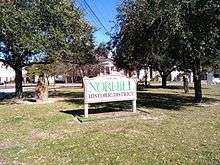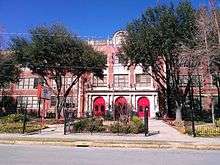Norhill, Houston
Norhill, Houston is an historic neighborhood in northwest-central Houston, TX (USA). It is adjacent to the more widely known Houston Heights neighborhood as well as Woodland Heights. Norhill is distinguished by its prevalence of bungalows and the green spaces known as esplanades.

History
Developed in 1920 by William C. Hogg, Norhill is divided into Norhill, North Norhill, and East Norhill.[1] The pastureland on which the neighborhood was built was originally owned by Henry Stude who purchased the land in 1873. Following Stude’s passing in 1905, his widow and children traded the land for stock in the Stude Holding Association which voted shortly thereafter to subdivide the land. By 1920, the Association had teamed with Hogg and changed their name to Varner Realty Company. The name Varner is reported to have come from “Varner Plantation”, the retirement home of Hogg’s father James Stephen Hogg, former Texas Governor. William C. Hogg was both Chairman of the City Planning Commission and a wealthy investor. He played an important role influencing the growth of Houston during the 1920s.[1][2]
Norhill was developed first in 1920 with 388 lots bordered by Studewood, Usener, Michaux, and Pecore Streets. North Norhill was developed next in May 1923 with 555 lots in an area bordered by Studewood, North Main, Michaux, and Pecore Streets. East Norhill was developed in June 1924 with 292 lots bordered by Michaux, Fugate, Moss, and Key Streets. Accessible by both streetcar and auto, Norhill grew with residents at a time when the population in Houston was booming and quality housing was in demand for working-class citizens.[1]
Architecture
Bungalows in Norhill were commonly built from commercially available plans sold through catalogs such as Ladies' Home Journal or Sears Roebuck and Co. and could be easily constructed on 50 by 100 foot lots.[1] With rooms that open up to each other and covered porches that provide an outdoor living space, the bungalow was an ideal home for Houston’s often warm and humid climate. As was popular during this time, Norhill homes were often built from a kit shipped directly to the lot containing all of the building materials needed for a particular design.[1]
Today, Norhill remains a “concentrated intact collection of houses built in various bungalow styles, many of which feature low-pitched roofs, simple designs, and trademark porches anchored by brick pillars and tapered wood columns."[3] Represented bungalow styles include Colonial, Spanish, Hipped, English and Craftsman.[4] Whereas the neighboring Houston Heights has many historic homes with Victorian flourishes, Norhill bungalows are generally distinguished by cleaner lines with minimal ornamentation.
Greenspace
Hogg’s interest in weaving green areas into housing developments is apparent. The Norhill esplanades are not unlike those incorporated into Hogg’s development of the affluent River Oaks neighborhood.[1] The long green esplanades lend a park-like feel to Norhill Boulevard, a north-south residential street which runs through much of the neighborhood. Hogg also incorporated space for a park into the layout. Sold to the City of Houston for $1.00, this area was developed into Proctor Plaza Park.[1]
Historic District Designation
Through the efforts of Norhill’s residents and what is now known as the Norhill Neighborhood Association, (formerly Proctor Plaza Neighborhood Association encompassing North and East Norhill) North Norhill and East Norhill were designated a Historic District in 2000 by the City of Houston and the Houston Archaeological and Historical Commission.[4]
Public schools

The Norhill neighborhood is within the bounds of the Houston Independent School District.[5]
Elementary schools serving sections of Norhill include Browning (between 11th Street and 14th Street),[6] Field (north of 14th Street),[7] and Travis in Woodland Heights (Norhill areas south of 11th Street).[8] James S. Hogg Middle School, the zoned middle school,[9] offers a magnet program for math, science, technology and robotics, while Heights High School (formerly Reagan High School), the zoned high school,[10] features the district's magnet school of computer technology.
Hogg, named after Governor of Texas James Stephen Hogg, was built on land that was reserved for school usage by the developer of Norhill.[11] James Hogg's family had donated the land occupied by the school.[12] It has 735 students as of 2015. 87% of the students are designated as low income, and the student body is majority Hispanic. The school occupies a three story 1920s building. The school uses the International Baccalaureate program.[13]
In the 2011-2012 school year, it had 700 students. 90% were Hispanic or Latino, 5% were black, and 3% were white. Almost all of the students were classified as low income through their qualifying for free or reduced lunches. As of 2011 few Woodland Heights/Norhill-area parents sent their children to Hogg, and they instead used HISD middle schools in other areas. As of 2014 the school's test scores were below average. By 2014 the IB program had been established, the number of disciplinary reports declined and became among the smallest in the entire district. There were efforts from area parents to attract graduates of Travis and Harvard elementary schools, two major feeder schools, to Hogg, and by 2014 the number of children from Travis and Harvard matriculating to Hogg increased by fewer than 50%.[12] In 2015 Annette Baird of the Houston Chronicle wrote that historically "had a reputation for poor student performance and low enrollment" but that it was increasing in popularity with local parents.[13]
Parks and recreation
Proctor Plaza Park is in East Norhill block 213.[14]
Biannual Norhill Bungalow Home Tour
Every other year, the Norhill Neighborhood presents a home tour featuring fine examples of Norhill bungalow architecture as a means to raise funds for the association. The last Norhill Bungalow Home Tour was held on Saturday, May 4th, 2019.
References
- City of Houston Historic Designation Report. (1999). Retrieved January 19, 2013 from http://www.norhill.org/wp-content/uploads/2012/02/norhill_historic_designation.pdf Archived 2016-02-13 at WebCite.
- http://www.lib.utexas.edu/taro/utcah/00008/cah-00008.html
- Soine, D. (2001, Issue 29). Norhill: Preserving a Piece of Houston's History. American Bungalow. Retrieved January 19, 2013 from http://www.norhill.org/wp-content/uploads/2012/02/Norhill_Bungalow_Magazine_article0001.pdf.
- Murtha, P. (2010, Vol. 1). Houston’s Norhill Historic District: An Unchanging Neighborhood in Changing Times. Texas Heritage: A Publication of the Texas Historical Foundation. Retrieved January 19, 2013 from http://www.norhill.org/wp-content/uploads/2012/02/Heritage_March_2010_Norhill_article_combined.pdf
- "Norhill Historic District" (Archive). City of Houston. Retrieved on February 12, 2016. Text description of the boundaries (Archive) - Inventory of properties (Archive). Some parts of Norhill are not in the historic district: "Historic District Designation Report - Norhill Historic" (Archive). City of Houston. p. 1 states: "The first phase of the develop (which is not part of this Historic District application and is referred to here as South Norhill), included the following boundaries: 11th Street (north); Studewood (west); Michaux (east) and Usener (south)." - Visual boundaries of all of Norhill are seen here: Map of Woodland Heights. Woodland Heights Association. Retrieved on February 12, 2016.
- "Browning Elementary School Attendance Zone" (PDF). Houston Independent School District. Retrieved 2019-04-08.
- "Field Elementary School Attendance Zone" (PDF). Houston Independent School District. Retrieved 2019-04-08.
- "Travis Elementary School Attendance Zone" (PDF). Houston Independent School District. Retrieved 2019-04-08.
- "Hogg Middle School Attendance Zone" (PDF). Houston Independent School District. Retrieved 2019-04-08.
- "Heights High School Attendance Zone" (PDF). Houston Independent School District. Retrieved 2019-04-08.
- "Historic District Designation Report - Norhill Historic" (Archive). City of Houston. p. 1-2/12. Retrieved on February 12, 2016. "The first phase of the develop[...]This area includes the site of James S. Hogg Junior High School[...]that was built on land reserved by the developer for school use for the entire Norhill development." The Harris County Block Books show the Norhill school site, which Hogg Middle occupies, in Volume 62 Page 56, page Norhill School Site (PDF and JPG)
- Hardy, Michael (2014-08-03). "The Return of the Neighborhood School". Houstonia. Retrieved 2017-02-27.
- Baird, Annette. "IB program helps Hogg campus make strides" (Archive). Houston Chronicle. Tuesday April 28, 2015. Retrieved on September 26, 2015.
- Harris County Block Book Maps. Volume 62, Page 126. East Norhill, Block 213 (PDF and JPG) - Marked as Proctor Plaza Park
External links
- Norhill Neighborhood Association (website for North Norhill and East Norhill)
- Houston Heights Association (website for the neighbording Houston Heights)
- Woodland Heights Civic Association (website for Norhill and the neighboring Woodland Heights)
- Houston Archaeological and Historical Commission (HAHC)
